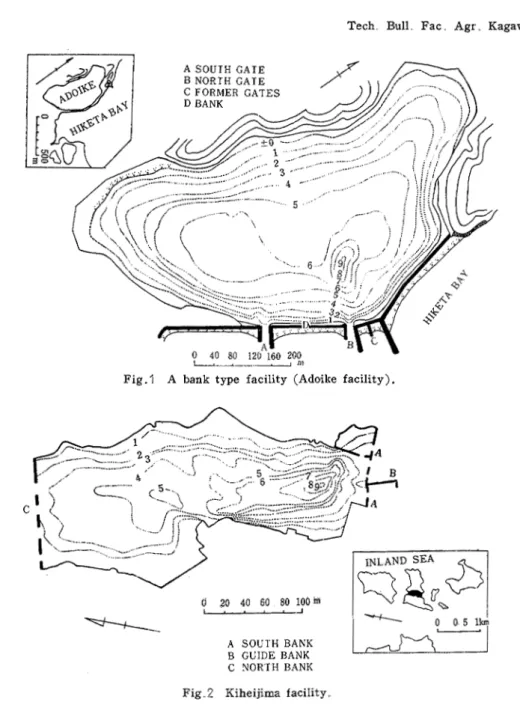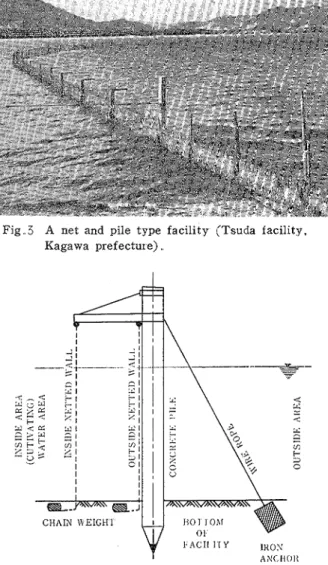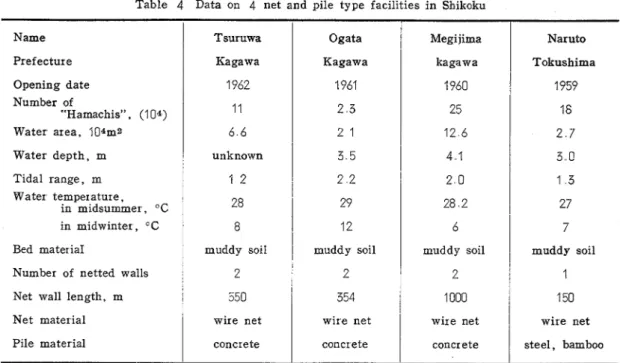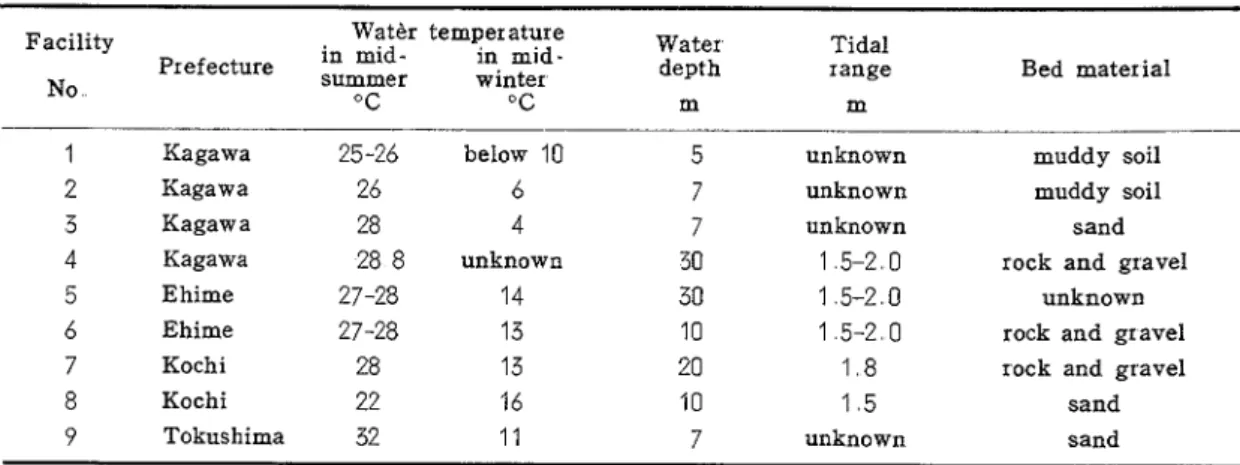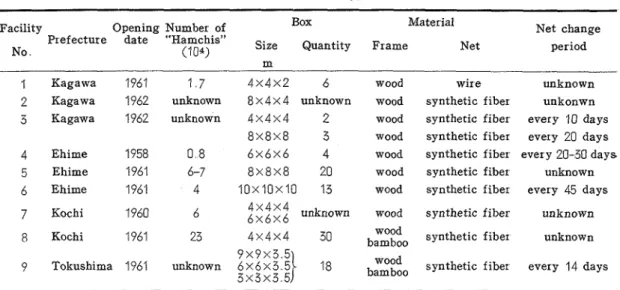Vol. 17, No 2 (1966)
A STUDY ON THE SHALLOW-MARINE
CULTURAL FACILITIES
ON T H E CURRENT CONDITION
OF T H E PISCICULTURAL
F'AClLITIES IN SHIKOKU, JAPAN
Kiyoshi FUKUDA,
Tadao MAEKAWA,
Minor u
SAITO
a n d Yoshihiro
KONO
Introduction
Japan has the largest fishing industry. In 1962, the Japanese catch amounted to 6.9 million metric tons, the Soviet Union 5.6 million and the United States 2.9 milli~n'~). The Japanese catch was primarily in the deep sea as was the Soviet Union and the United States.
Japan had two large fishing areas before the war, one in Eastern Asis from Formosa to t h e Bering Sea, particularly Korea, Sakhalin, and the Kuleles; and the other along the entire Siberian Coast. Today these are closed to Japan. Consequently, coastal fishing i s limited to the narrow coast of the four main islands of Japan.
Because of 1 ) the limited fishing area,
2)
the changed location of the schools of fish and 3) the consequent over fishing , coastal fishing industry has low productivity. T O adapt itself to the decreased coastal fishing, the government policies changed from fish catching to fish cultivating.The execution of the new policies are still in a early stage, consequently, a number of pisciculture facilities were built and are still being built on a trial and error bases. To help increase the productivity of the coastal fishing industry, it is irr~portant and necessary t o find out the current conditions of the pisciculture facilities and to systematize them.
With this objective, we are now carrying out practical research a t the pisciculture facilities throughout Japan The report presented here is the result of the practical research carried out throughout Shikoku in 1962 and 1963.
Methods
To g a t h e ~ data of the various pisciculture facilities, we visited the facilities and asked the directors and workers the questions on the data paper. The major items of the data paper are 1 ) the facility name, place and water area, 2) the natural conditions such a s wind directicn, water temperature, water depth and tidal range, 3 ) the opening date of the facility and the number and kind of species cultivated each year, 4) the present number and kind of species, the kind of feed and where it is obtained, and the market of the species, 5 ) types and construction of the facility and 6 ) the current problems and the futur e plans of the facility.
Tech Bull Fac Agr Kagawa Univ. Results and discussion
Distribution of the Facilities
On the Table 1, the number of pisciculture facilities in Shikoku is compared with the total number of facilities i n Japan c2). There are 173 facilities in Shikoku and this is about 27.6 per cent of the total in Japan.
Table 1 Number of pisciculture facilities in Shikoku
(B) Japan
1
96 Facility**
Bank : Bank type facilities Net B : Net box type facilities Net W : Net wall type facilities Fish P. : Fish Preserved type facilities C Net : Circled net type facilities Other types for me^ salt fields etcOther
Bank Net W C. Net Net B Fish P Total
types
The types of facilities are also listed in Table 1. In Shikoku, there are 57 fish preserved facilities, which is about 66.3 per cent of the total number in Japan ; 16 net wall type facilities, 21 .I per cent; 64 net box facilities, 20.1 per cent; 15 bank type facilities, 15.6 per cent; 8 circled net type facilities, 49.0 per cent; and 13 others type facilities, 43.3 per cent.
- -- - ---
( A ) Shikoku 16 8 64 57 13 1 73
Table 2 Number of pisciculture facilities in each prefecture in Shikoku
I
Other PerPrefecture Bank Net W C Net Net B Fish P Total
types cent 1 --. --- - Kaga wa
1
7 11 7 19 30 4 78 45 1 Tokushima 2 2 - 6 4-
14 8 1 Kochi 1 1 1 8 3 - 14 8 1 Ehime I 5 2 - 31 20 9 67 38 7 Total1
15 16 8 64 57 13 173 100 -- - -Per cent 1 8 7 9 2 4 6 3 7 0 3 3 0 7 5 100 IThere are 4 prefectures in Shikoku and t h e facilities in each prefecture are listed in Table 2
.
Kagawa Prefecture has 78 facilities, 45.1 per cent of the total number of facilities in Shikoku. In short, half of the facilities in Shikoku are in Kagawa Prefecture. In Ehime Prefecture, there are 67 facilities, 38.7 per cent of the total number in Shikoku. Thus, most of the facilities in Shikoku are in Kagawa and Ehime Prefectures. However.Vol . 17, No2 (1966) 127 t h e water temperature i n Kagawa goes below 1O0C in rnidwinte~ thus they cannot market their fish late i n the winter when the price a r e good whereas Tokushima, Kochi and Ehime take advantage of the higher market prices.
The facilities in Shikoku a r e concentrated on the bays and islands along the Inland Sea a n d t h e Bungo Channel. Bays, s t r a i t s , and lagoons a r e widely used for pisciculture facilities.
According t o shoreline geomorphology, t h e shoreline along the Bungo Channel and t h e Inland Sea is a shoreline of submergence which is a shoreline that has submerged and has many bays and islands. On the other hand, there a r e ver y few bays and islands along t h e shoreline of t h e Pacific Ocean T h u s , t h e ~ e a r e only a few facilities i n Tokushima and Kochi Prefectures
.
Current Conditions of the Facilities
On Table 2, Table 3 and in previous papers we classified the facilities according t o t h e method of enclosure. However, from this p ~ i n t on we are classifying t h e facilities t h a t use enclosure nets in a net support type classification such a s "net and pile" and "net a n d float
'.
Hereafter in this paper, t h e facilities are classified as bank t y p e , net and pile type, n e t a n d float t y p e , net box type facilities.
1 ) Bank
As shown i n F i g . 1 , the water area used for cultivating is enclosed by concrete or stone bank and has several water inlets. We will refer to this type as "bank" type. Some typical bank type facilities a r e Adoike , Kiheijima and Yokonami
.
1 - 1 ) Adoike Facility
Adoike t h e oldest and the largest pisciculture facility was built in a lagoon i n Kagawa Prefecture i n 1927 with a water area of about 26X104m2. The lagoon was enclosed b y a stone bank that was built on top of a sand bar. I t has two inlets as shown i n Fig. 1. T h e water inlet built on the south side of the stone bank was made with concrete hume pipes. T h e other water inlet on the north side of the stone bank consists of five screen water gates. I n this wateI area, they raised about 2 0 x 104 "Hamachis" (The young of Serzola quznqueradzate) in 1962.
According t o hydraulic observations, the increase i n water volume during the flood tide equals the decrease i n water volume during t h e ebb tide. Since the facility has no outlet beside t h e two inlets, the quantity of inflowing water during t h e flood tide i s of course equal to t h e increased water volume during the flood tide. T h e increase during t h e flood tide is only 10 to 20 per cent of the volume of t h e sea water a t the low tide.
1
-
2 ) Kihei jima FacilityKiheijima Facility is a typical example of a pisciculture facility built on a strait. I t was built in Kagawa Prefecture i n 1933. The sea water area is about 5 x l 0 4 m 2 , and i n this water area they raised about 9 . 5 ~ 104 "Hamachis" in 1962. The strait was enclosed by stone banks on the scuth and north mouth of t h e strait. Each bank has
4
iron screen water gates and the south bank has a guide bank a s shown in Fig.2.Tech Bull. Fac Agr. Kagawa Univ..
Fig.1 A bank type facility (Adoike facility).
Fig ..2 Kiheijima facility.
According to hydraulic observations('), the sea water in this facility flows from the south gates through the north gates in flood tide and it flows in the opposite direction in ebb tide.
The quantity of t h e sea water inflow and outflow during one tide was obtained to be about 25.5X 104mS. The water volume at low tide was calculated to be about 6.7X 104mS. Thus, during one tide the sea water flows through the facility a t about
4
times the sea water volume a t low tide.Thus, Kiheijima Facility has a much better exchange of sea water than Adoike Facility which may explain why they can raise a larger number of fishes per unit water area or per. unit volume than they can a t Adoike Facility.
1 - 3 ) Yokonami Facility
Some bank type facilities have a channel or a pipe line to the outside sea or bay through the side of the enclosed bay to increase the exchange of sea water.
A channel, 14 m in width 3 m in depth and 30 m i n length, was constructed on the west side of the bay at Yokonami, Kochi Prefecture in 1961. I t was constructed after all the fishes died, about 10 x 104 "Hamachis", due to the poor condition of the water caused by the poor exchange of sea water. After talking to some members of the facility, the channel has not been a s helpful as they wanted. T h e degree of help channels or pipes give to a facility i s brought out in the report "Water Capacity of the Channel Constructed at Tanoura Facility, Kagawa Pr efecture".
Naruto Tokushima 1960 2 0 4 3 unknown 29 5 muddy soil nuknown 1 unknown Table 3 Data on 5 bank type facilities in Shikoku
The detail of 5 bank type facilities are listed in Table 3. The number of fishes being ~ a i s e d varies from about 2 x 104 "Hamachis" (at Naruto) to about 20 x 104 "Hamachis" (at Adoike)
.
The sea water area varies from about 0.4 x 104m2 (at Naruto) to about 26x 104m2 (at Adoike).
The mean water depth varies from 3 m (at Naruto) to about 7 m (at Yoko- nami). The length of the bank varies from 226m ( a t Yokonami) to about 550m ( a t Ojigaura).
Number of gates varies from 1 (at Naruto) to 14 (at Yokonami).
The bed material is muddy soil at all of the facilities. The water temperature of the sea water a t the facilities varies from about 27°C (at Adoike, Ojigaura) to about 32OC (at Yokonami) in midsummer: it varies from approximately 5°C (at Naruto, Kiheijima) to about 7OC (at Ojigaura) in midwinter. As long as the water temperature is above 1O0C, "Hamachis" can be cultivated through the winter.2 ) Net and Pile
As shown in Fig.3 piles are placed in 5 to 10m intervals across a bay and are connected together by several strips of steel or iron bars. A net wall is placed on these
Name Prefecture Opening date Number of "Hamachis", (104) Water area, 104m2 Water depth, m Tidal range, m Water temperature in midsummer, OC in midwinter, OC Adoike Kagawa 1927 20 26 6 5 1 8 27 unknown
Ojigaura Kiheijima Yokonami Kagawa
1
Kagawa Kochi1959 12 7 . 7 7 2.0 32 unknown muddy soil 226 14 concrete 1961 15 8 . 3 5 2 . O 27 7 muddy soil 550 Bed material
I
muddy soil1933 9 . 5 5 4 2 0 30 5 muddy soil 240 Bank length, m Number of gates Bank mater ial
8 stone stone 480 2 stone I
1 30 Tech Bull Fac Agr Kagawa Univ.
Fig 3 A net and pile type facility (Tsuda facility, Kaeawa ~refecture)
.
steel bars a n d the bottom of the net is secured in place with chain wei- g h t s . The cultivating is done i n t h e water area enclosed b y t h e netted wall and we refer to this type of pisciculture facility a s a "net and pile" type facility.
F i g . 4 shows a profile of a net and pile type facility. A concrete pile, 30-45cm i n diameter and 10- 30m i n length, i s penetrated into the bottom of t h e bay (wooden piles, bamboo piles and steel piles a r e also used). T o support t h i s pile, two braided wires ropes are tied to the pile about I m above t h e water level and they are anchored to bottom of t h e bay on the outside of t h e cultiv- ating area.
Horizontal steel bars a r e used to connect t h e piles and they are placed in about 2 m intervals on the inside of t h e pile. T h e top bar i s about Im above H.H.W.L. (Higher High Water Level) and bottom bar is placed on the bottom of t h e bay. T h e number of bars between the top and the Fig..4 A profile of a net and pile type facility.. bottom depends on the water depth. A wire net protected by a coating of polyethylen is used for the outside net and i t is tied t o the connecting bar with a polyethylen protected wire which is about 2mm in diameter. T h e wire net is folded under t h e bottom connecting bar and about 1 m is extended t o the inside. Chain weights are placed on top of t h e extended wire net.
Data on
4
net and pile type facilities i n Shikoku are listed i n Table 4. T h e number of fishes being raised varies from 2.3x 104 "Hamachis" (at Ogata) t o 25
x 104 "Hamachis" (at Megijima). T h e water area varies from 2.1x
104m2 (at Ogata) to 12.6X 104m2 (at Megijima). T h e mean water depth is from 3.5m (at Ogata) t o4.1
m (at Megijima). T h e tidal range varies from 1 . 2 m (at Tsuruwa) t o 2.2m (at Ogata). T h e water temperature varies from 2T°C (at Naruto) to 2q°C (at Ogata) i n midsummer; a n d from b°C (at Megi- jima) to 1z0C (at Ogata) in midwinter. T h e bed material a r e muddy soil. T h e length of t h e net wall varies from 150 m (at Naruto) t o 1,000m (at Megijima). Double netted walls a r e used a t all of the facilities except a t Naruto. All t h e facilities used wire net.Table 4 Data on 4 net and pile type facilities in Shikoku Name Prefecture Opening date Number of "Hamachis", (1 04) Water area, 104m2 Water depth, m Tidal range, m Water temperature, in midsummer, " C in midwinter, OC Bed materia1
Number of netted walls Net wall length, m Net material Pile material Tsuruwa Kagawa 1962 11 6 6 unknown 1 2 28 8 muddy soil 2 550 wire net concrete Ogata Kagawa 1961 2 3 2 1 3 5 2 2 29 12 muddy soil 2 354 wire net concrete Megi jima kagawa 1960 25 12 6 4 1 2 0 28 2 6 muddy soil 2 1000 wire net concrete
I
Naruto 1 3I
27 7 muddy soil 1 1501
wire netI
steel, bamboo Concrete piles are used at 3 facilities: steel and bamboo piles are used at one facility.3 ) Net and Float
Bays that are enclosed by net walls and kept in place with floats on the top and chain weights at the bottom are called "net and float" type facility. Tanoura Facility is an example of this type as shown in Fig.5.
3
-
1) Tanour a FacilityTanoura Facility was built in Kagawa Prefecture in 1960. Its water area is about 19.8X 104m2. In this water area they raised about 28.5 x 104 "Hamachis" in 1962.
A profile of the netted walls and the floats is shown i n Fig.6. Double netted walls are used as the enclosesure net and a guard net is placed on the outside of the double netted wall. Marine creature, vegetation and waste gather on the meshes of the double netted wall. Consequently, the net must be change every 10 to 45 days depending on the mesh and season. (See the section on Net Box for further details.)
A water channel, 22m2 in cross section and 140 m in length, was constructed on the south side of the facility to increase the inflow and outflow of fresh sea water. But according to the hydraulic observations, the quantity of sea water that comes through this channel is only several per cent of the incresed volume of sea water in the facility during one tide. (The details are in "Water Capacity of the Channel Constructed at Tanoura Facility, Kagawa Prefecture" report in this bulletin. )
Data on 4 net and float type facilities in Shikoku are listed in Table 5. T h e number of fishes being raised varies from 4x204 "Hainachis" (at Anago) to 2 8 . 5 ~ 104 "Hamachis" (at Tanoura). The water area varies from 0 . 5 ~ 104 m2 (at Tsubakidomari) to 19 8 x 104 m2 (at Tanoura)
.
The mean water depth varies from 4 5 m (at Anago) to 10m ( a t Tanoura, Futomi).
Tidal range karies frcm 1 8m (at Futcmi) to 2.Cm (at Tancura, Tcubzkidcmari,132 T e c h Bull Fac Agx Kagawa Univ.
and Anago). T h e water temperature varies from 2q°C (at Tanoura, Anago) to 30°C (at Futomi, Tsubakidomari) in midsummer; and from 4OC (at Anago) to 12OC (at Futomi) in midwinter. The bed materials are muddy soil, and sand. They used double netted walls
at all of the facilities. Net wall length a r e from 160m (at Tsubakidomari) to 570m (at Tanoura). All of the facilities use synthetic fiber nets.
E L O A I F I O A I l s I O A l
C H A I N CHAIH O F Fig,,7 A net box type facility..
I R O N R'EICHT \!'EIGHT
ANCHOR FACILITY
6:pCNHoR
F i g . 6 A profile of a net and float type facility
4 ) Net Box
As shown in Fig.7, an open box ( a net box having no lid) is suspended in the sea water with about 0.2-0.5m of the box extending above the water. The cultivating is done in this box. This is refered t o as "net box" type facility. Synthetic fiber net i s generally used and the boxes a l e generally square ox rectangular. The detail is listed in Table 6, 7, and 8.
Table6 shows the natural condition of the water area where the net box facilities a r e placed. The water temperature are from 22°C to 3Z0C i n midsummer and from 4OC to 16°C in midwinter. The water depth are from 5 m to 30m. The tidal range are from 1.5m to 2 m. The bed materials are muddy soil, sand, and rock and gravel.
Table 5 Data on 4 net and float type facilities i n Shikoku
Name Prefecture Opening date Number of "Hamachis", (1 04) Water area, 104mz Water depth, m Tidal range, m Water temperature, in midsummer, OC in midwinter, " C Bed material
Number of netted walls Net wall length, m Net material Anago Kagawa 1961 4 5 9 4 5 2 0 29 4 muddy soil 2 340 synthetic fiber Tanour a Kagawa 1960 28 5 19 8 10 2 0 29 5 muddy soil 2 570 synthetic fiber Futomi Kochi 1961 15 1 10 1 . 8 30 12 Tsubakidomari Tokushima 1962 15 0 5 6 2 0 30 8 sand sand
synthetic fibex synthetic fiber
Table 6 The natural condition of the water area of 9 net box type facilities in Shikoku
Facility Water temperature Water
Prefecture winter in mid- depth
No "C " C m
Tidal
range Bed material
Kagawa 25-26 Kagawa 26 Kagawa 28 Kagawa 28 8 Ehime 27-28 Ehime 27-28 Kochi 28 Kochi 22 Tokushima 32 below 10 6 4 unknown 14 13 13 16 11 unknown unknown unknown 1 5-2 0 1 5-2 0 1 5 - 2 0 1 8 1 5 unknown muddy soil muddy soil sand rock a n d gravel unknown rock and gravel sock and gravel
sand sand
134 I'ech. Bull, Fac. Agr. Kagawa Univ . Table 7 T h e structure of 9 n e t box type facilities i n Shikoku
Facility Opening Number of Box Material Net change
Pref ectur e date "Hamchis" Size Quantity
No (104) . , Net period Kagawa 1961 1 7 Kagawa 1962 unknown Kagawa 1962 unknown Ehime 1958 0 8 Ehime 1961 6-7 Ehime 1961 4 Kochi 1960 6 m
--
4 X 4 X 2 6 8 ~ 4 x 4 unknown 4 X 4 X 4 2 8 x 8 ~ 8 3 6 x 6 ~ 6 4 8 X 8 X 8 20 1 0 ~ 1 0 ~ 1 0 13 4 ~ 4 x 4 6 unknown wood wood wood wood wood wood wood wood wire synthetic fiber synthetic fiber synthetic fiber synthetic fiber synthetic fiber synthetic fiber synthetic fiber unknown unkonwn every 10 days every 20 days every 20- 30 d a y s unknown every 45 days unknown8 Kochi 1961 23 4 ~ 4 x 4 30
bzEto
synthetic fiber unknown 9 x 9 ~ 3 59 Tokushima 1961 unknown 6 X 6 x 3 51 18
br::to
synthetic fiber e v u y 14 days 3 x 3 ~ 3 51Table 7 shows the opening date of the net box facilities and their structures. Most of them were built in a short period between 1960 to 1962. The boxes are from 3 ~ 3 ~ 3 . 5
to l o x l o x 10m with wood and bamboo frames. Synthetic fiber net i s generally used, however, there are a few wire net boxes. The net is changed every 10 to 45 days de,- pending on the amount of debris that accumulates on the net. The mesh size of t h e net are changed depending on the growth of the cultivating fish. The size of the mesh i s measured by counting the number of knots in 5 "Sun" (16.5cm) of net that is held
Table 8 lists when the different size mesh are used at Ehime and Kochi Prefectures. In the first stage of the cultivating, a knot-less net is generally used. The fishes a r e separated into various sizes when they are first placed into the boxes and a s they grow, since the growth rate of the fishes differ. This is to plevent the bigger fishes from eating the smaller fishes.
At the facilities listed on Table 8 , the "Hamachis" are raised in the net boxes until Table 8 The size of mesh and the period of they are mzrketed. At the big facilities, uses in the net box type facilities in however, the "Hamachis" are released
Shikoku from the net boxes into the facility itself
The mesh of the net when they are big enough. A t Adoike The period
Facility N ~ . 4 Facility N ~ . 7 Facility, in the middle of April or May of uses
- (Ehime ) (Kochi ) depending on the wster temperature they May and June knot less knot less buy "Hamachis" that a r e caught in the sea near Kochi Prefecture and they a r e July and August 18 knots 14 knots
pIaced in several net boxes inside the September and 10 to 12 knots
October 10 knots Adoike Facility preferably where t h e flow November and 7 to 8 knots of the sea water is considered to be good,
Vol 17, No 2 (1966) 135
until they a r e big enough to be released from the boxes into the large water area of the facility.
Net boxes a r e easy to handle, inexpensive t o construct, and can be moved easily in case of danger. To protect i t from the typhoon, they can be moved to a safe place or they can be sunk below the water level if a lid is placed on the top. Furthermore net boxes a r e considered to be the best type of facility for the exchange of fresh sea water.
Because of these factors, there are a large number of net boxes throughout Japan and they will probably be used even more in the future.
Summary
TO find out the current condition of the pisciculture facilities, practical research was carried out throughout Shikokn, Japan, in 1962 and 1963. The main points of the research and the current problems of the facilities are presented below:
There are 173 facilities in Shikoku which is about 30 per cent of all t h e facilities in Japan. These facilities are classified a s (a) Bank type facility (b) Net and Pile type facility (c) Net and Float type facility (d) Net Box type facility.
Most of the facilities were constructed in three short years from 1960 to 1962 on a trial and error bases. Thus, there are many problems to be solved to make the facilities productive.
These facilities are concentrated along t h e Inland Sea and t h e Bungo Channel shorelines, thus, most of the facilities in Shikoku are in Kagawa and Ehime Prefectures.
The amount of fresh sea water that comes in with t h e tide is small compared to t h e total volume of the enclosed area causing a shortage of oxygen. This caused the death of the entire colony of fish a t several facilities. T o help increase t h e oxygen level of the sea water, an open channel or a pipe line was constructed through the side of some large facilities to increase the exchange of sea water, but the actual degree of help this rendered is still unknown.
Nets are changed every 10 to 45 days to g e t rid of t h e sea debris that obstructs the flow of sea water through the net.
Further investigation is needed to recommended better methods and better structures to increase productivity.
Acknowledgements
T h e writers wish to thank the directors of the facilities and their workers for their help, and also MIS Chieko MATSUBARA a member of our laboratory for her assistance
References
(1) FUKUDA K., MAEKAWA T . , SAITO M , and Univ , 16,151 (1965)
KONO Y.; Tech Bull Fac Agr , Kagawa (3) The Mainichi Press Ltd: The Maznzchz Year
Unzv , 17, 36-41 (1965) Book, 934 (1965)
(2) MAEKAWA T , SAIIO M , FUKUDA K , and (4) MIYAMOIO H : Gyogu Gyohogaku, 76-88, KONO Y ; T e c h Bull Fac A g r , Kagawa Tokyo, Kinbara (1962)

